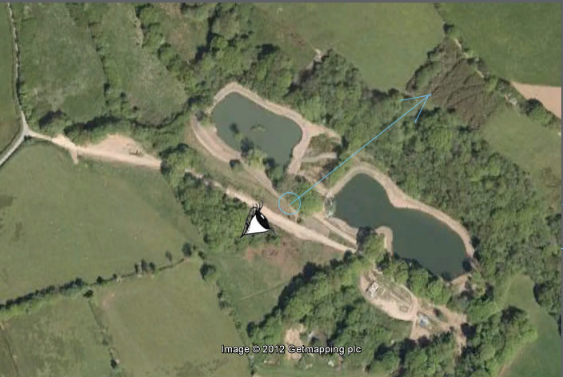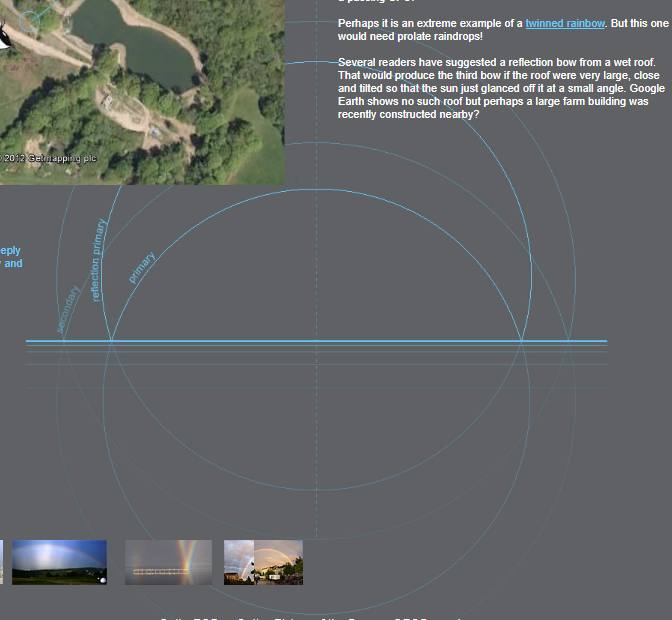OPOD - Anomalous Rainbow, Devon, England
OPOD - Anomalous Rainbow, Devon, England: Exploring the Mysterious Phenomenon
Rainbows are nature's captivating optical displays that never fail to mesmerize us. They are formed when sunlight is refracted, reflected, and dispersed by water droplets in the air, creating a beautiful spectrum of colors. However, there are instances when rainbows defy our expectations and exhibit anomalous characteristics. One such intriguing phenomenon was captured in Devon, England, by photographer Jim Ryan and shared with the Optical Physics of the Atmosphere (OPOD) community. This article delves into the details of this anomalous rainbow and attempts to unravel its mysterious nature.
A Triple Rainbow with an Unusual Addition
Jim Ryan managed to capture a triple rainbow using his iPhone camera, and it was subsequently shared with OPOD by Pete Glastonbury. The primary and secondary rainbows were expected sights, but sandwiched between them was an unexpected third rainbow. Its presence raised questions and ignited curiosity among atmospheric optics enthusiasts.
Puzzling Explanations and Intriguing Theories
Upon first glance, one might assume that the third rainbow is a reflection bow caused by sunlight bouncing off mirror-smooth water surfaces. However, this theory falls short when considering the positioning and tilt of the rainbow. Reflection bows typically appear at sharper angles upwards and would require perfectly aligned smooth water surfaces. In this case, the positioning and tilt of the rainbow do not align with the expected characteristics of a reflection bow.
Another theory suggested by some readers is that the third rainbow could be an extreme example of a twinned rainbow. However, for this explanation to hold true, raindrops would need to have a highly elongated shape, which is quite rare.
Unveiling the Mystery: A Wet Roof or New Construction?
One intriguing suggestion proposed by several readers is that the third rainbow could be a result of sunlight reflecting off a wet roof. If the roof were large, close, and tilted at a specific angle, the sun's rays might glance off it, creating the third bow. However, a search using Google Earth did not reveal any such roof in the vicinity. Alternatively, it is possible that a large farm building was recently constructed nearby, which could explain the presence of the anomalous rainbow.
Seeking Clarity through Further Investigation
The nature of this anomalous rainbow in Devon, England, continues to captivate and perplex observers. While theories have been put forth to explain its existence, no definitive conclusion has been reached. To shed more light on this phenomenon, additional research and investigations may be required.
The Beauty of Atmospheric Optics
This anomalous rainbow serves as a reminder of the captivating beauty and complexity of atmospheric optics. Nature has a way of surprising us with its intricate displays and phenomena that challenge our understanding. By exploring these anomalies, we deepen our knowledge of the natural world and gain a greater appreciation for its wonders.
Conclusion
The triple rainbow captured by Jim Ryan in Devon, England, with its enigmatic third addition, adds another layer of intrigue to the world of atmospheric optics. Despite various theories proposed to explain its existence, the mystery remains unsolved. The anomalous rainbow serves as a testament to the intricacies of nature's optical phenomena, reminding us that there is always more to discover and explore. As we continue to unravel these mysteries, we deepen our understanding of the world around us and marvel at its boundless wonders.

Another Anomalous Bow
A triple rainbow imaged by Jim Ryan on his iPhone and brought to OPOD by Pete Glastonbury.
South of Barnstaple, Devon, England. "Wet and windy.. .. showers passing by quickly with rain coming down in sheets.. ..only had time to take one photo before it disappeared."
©Jim Ryan, shown with permission.

Sandwiched between a bright primary bow and a reverse colour secondary is an anomalous third rainbow.
As in an earlier OPOD, first thoughts are that it is a reflection bow produced by sunlight beaming upwards from mirror smooth water.
There were indeed two small pools each side of the imaging point but the bow is in the wrong position and tilted completely wrongly for it to be formed by reflection from a smooth pool. The reflection bow 'should' be angled more sharply upwards. Perhaps the water was not smooth? Perhaps it had waves tilted at just the right angle? But that is wildly improbable - we could as likely invoke the downdraft of a passing UFO.
Perhaps it is an extreme example of a twinned rainbow. But this one would need prolate raindrops!
Several readers have suggested a reflection bow from a wet roof. That would produce the third bow if the roof were very large, close and tilted so that the sun just glanced off it at a small angle. Google Earth shows no such roof but perhaps a large farm building was recently constructed nearby?

Reflection bows angle steeply upwards between primary and secondary
Note: this article has been automatically converted from the old site and may not appear as intended. You can find the original article here.
Reference Atmospheric Optics
If you use any of the definitions, information, or data presented on Atmospheric Optics, please copy the link or reference below to properly credit us as the reference source. Thank you!
-
<a href="https://atoptics.co.uk/blog/opod-anomalous-rainbow-devon-england/">OPOD - Anomalous Rainbow, Devon, England</a>
-
"OPOD - Anomalous Rainbow, Devon, England". Atmospheric Optics. Accessed on November 22, 2024. https://atoptics.co.uk/blog/opod-anomalous-rainbow-devon-england/.
-
"OPOD - Anomalous Rainbow, Devon, England". Atmospheric Optics, https://atoptics.co.uk/blog/opod-anomalous-rainbow-devon-england/. Accessed 22 November, 2024
-
OPOD - Anomalous Rainbow, Devon, England. Atmospheric Optics. Retrieved from https://atoptics.co.uk/blog/opod-anomalous-rainbow-devon-england/.